|
|
|
Sort Order |
|
|
|
Items / Page
|
|
|
|
|
|
|
| Srl | Item |
| 1 |
ID:
169999
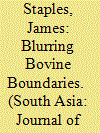

|
|
|
|
|
| Summary/Abstract |
Drawing on ethnographic fieldwork with butchers, cattle traders and beef eaters in South India, the aims of this paper are twofold. Firstly, it challenges two dominant assumptions made in respect of cattle slaughter and beef consumption in South Asia: one, that the beef trade directly concerns only Muslims, Dalits, Adivasis and Christians, and two, that respect for cattle is the near sole preserve of upper-caste Hindus. Secondly, given the strength of the empirical evidence against these two assumptions, it considers how such a stark framing of the debates along caste and communal lines has been sustained so successfully and for so long. Using insights from the anthropology of ignorance—to which this article makes a unique contribution—I argue that part of the answer lies in the strategic acts of not knowing what goes on at particular junctures along the chain from the cowshed to the dinner plate, which a number of different actors are complicit in working to maintain.
|
|
|
|
|
|
|
|
|
|
|
|
|
|
|
|
| 2 |
ID:
169997
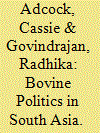

|
|
|
|
|
| Summary/Abstract |
This introduction outlines how the essays in this special section contribute to scholarship on cow protection in India. It argues that they disrupt three powerful framing binaries—religion/economy, legality/illegality and cow-lover/cow-killer—that have tended to dominate the literature on cow protection. Making tangible the analytical limits of these categories, the essays find new critical leverage in the everyday situated relationships between humans, bovines and the state. The essays are distinguished by their attention to bovines as creative and productive forces that are not mere symbols for human politics, but materially embodied and agentive beings that play a significant role in shaping the social and political worlds which emerge around them.
|
|
|
|
|
|
|
|
|
|
|
|
|
|
|
|
| 3 |
ID:
169994
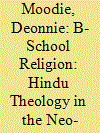

|
|
|
|
|
| Summary/Abstract |
In the industrial sector of Kolkata’s Salt Lake township, the spires, shikaras and domes of religious sites that are interspersed throughout the city proper are absent, and high-rise glass and metal buildings housing multinational corporations, hotels and shopping malls take their place. But religion is not absent there. Instead, management professors and business leaders transform those buildings into temples by framing the labour that takes place within them as a sacrificial act of worship. With this case study, I demonstrate that Hindu theologies are actively shaping and being reshaped by neo-liberal capitalism and its urban topologies.
|
|
|
|
|
|
|
|
|
|
|
|
|
|
|
|
| 4 |
ID:
169998
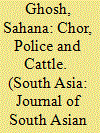

|
|
|
|
|
| Summary/Abstract |
India’s border with Bangladesh figures in the Indian national imagination as a unifying construct for multiple anxieties from illegal immigration to cattle smuggling, thus garnering public support for increased border security. What does a view from the lived and messy realities of the borderlands offer when we shift our focus from the fetish of the borderline as a political and religious marker of difference? This essay tracks the binary of legal–illegal through which cattle in the borderlands are framed, showing how bovines move across different terrains of the agrarian, the sacrificial and everyday cross-border trade in the borderlands and so resist this binary.
|
|
|
|
|
|
|
|
|
|
|
|
|
|
|
|
| 5 |
ID:
170003
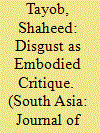

|
|
|
|
|
| Summary/Abstract |
Hindu nationalist discourse articulates a link between the violence of slaughter and the notion of a violent, abject Muslim as the cruel ‘other’. However, for Muslims in Mumbai, the cruelty of slaughter is not inherent, and questions of order and propriety are heavily circumscribed by communal politics. This paper presents moments during Bakri Id (Qurbani) and everyday life when participants evoke or experience disgust. Drawing on a discursive tradition of slaughter, together with everyday observations on infrastructure, order and marginalisation by middle-class Muslims from various walks of life, focuses attention on the way disgust is and is not experienced by Muslims in the city. I argue that these instances of disgust are moments of embodied critique that secure the middle-class Muslim as subject by pointing to the histories of marginalisation, infrastructural neglect and improper religious practice.
|
|
|
|
|
|
|
|
|
|
|
|
|
|
|
|
| 6 |
ID:
169995
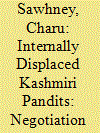

|
|
|
|
|
| Summary/Abstract |
A large-scale displacement of Kashmiri Pandits occurred in 1989–90 when Kashmir came under the control of secessionist groups. The successful resettlement of these refugees was dependent on their access to cultural and social capital. For the migrants from rural areas of Kashmir, resettlement was accompanied by occupational rupture because they had lost their immovable assets such as land and crops. By contrast, Kashmiri migrants from urban areas had greater access to cultural and liquid capital, which enhanced their ability to pick up their lives. This paper demonstrates that access to educational qualifications, and social and cultural capital, had a determining effect in perpetuating class inequalities among Kashmiris in their new locales.
|
|
|
|
|
|
|
|
|
|
|
|
|
|
|
|
| 7 |
ID:
170002
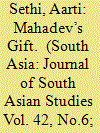

|
|
|
|
|
| Summary/Abstract |
In October 2016, protests erupted across southern India opposing a Supreme Court judgement banning an annual agricultural festival featuring jousts between men and bulls. The Court ruled the contests as infringing animal rights. Rural constituencies rallied behind the festival as a customary practice and symbol of agrarian culture. This essay suggests that the conflict between the two constituencies turns on whether animals are legal subjects or social persons. I analyse this festival-complex in Maharashtra to show that the ritual imagines animals not as rights-bearing species, but as members of the agricultural community. The rite does not disavow violence, rather it embeds its symbolisation within familial and productive relations between people and bullocks.
|
|
|
|
|
|
|
|
|
|
|
|
|
|
|
|
| 8 |
ID:
169996
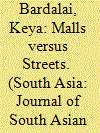

|
|
|
|
|
| Summary/Abstract |
This paper explores the experiences of migrant women from Northeast India who work in retail stores in malls in Delhi and Gurgaon, and the conflicting discourses of modernity and marginality which they negotiate at work and outside work. Managers of high-end retail stores in malls view these women as ‘modern’, ‘global’ and reflective of the aesthetic sensibilities of the brands they are hired to sell. For this reason, north-eastern women’s bodies and identities are ‘valued’ and ‘sought after’ by retailers and recruiters. Yet, outside, especially on the streets of Delhi, the same women whose aesthetic and modern attributes are valued at the workplace are subject to racial and sexualised stereotyping that labels them as ‘promiscuous’, ‘provocatively dressed’ and lacking in sexual respectability. This paper describes the spatial practices of north-eastern migrant women as inscribed by the shifting landscapes of modernity and marginality that they must negotiate as they reconcile their different public identities in the city.
|
|
|
|
|
|
|
|
|
|
|
|
|
|
|
|
| 9 |
ID:
169992
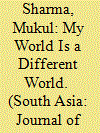

|
|
|
|
|
| Summary/Abstract |
India ‘nature writing’ has traditionally encompassed ecology, geography and sacrality, and has often missed Dalit literary traditions. In the last few decades, environment literature has expanded its horizons to consider intersections between ecology, society and culture. However, the question still remains: why is there no recognition of ecological underpinnings in the writings of subordinate castes by the wider canon of the environmental literary sphere? This article addresses this exclusion and explores the relationship between caste, nature, Dalits and environmental imagination. It takes Dalit autobiographies from different regions and languages to highlight an unexplored aspect of Dalit writings, thus widening the scope and perspective of environment literature and providing a distinct perspective from the margins. Through the lens of eco-literature, eco-criticism and eco-justice, the article underlines how nature’s beauty and caste burden, space and identity, land and bondage, social injustice and environmental ‘othering’ are significant features of these life narratives. It weaves certain select themes like nature’s beauty, caste exploitation, labour and animals to explore the pain and stigmatisation, along with a vibrancy and dynamism, in Dalit eco-narrations of the self.
|
|
|
|
|
|
|
|
|
|
|
|
|
|
|
|
| 10 |
ID:
170000
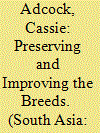

|
|
|
|
|
| Summary/Abstract |
Many of the controversial actions of the central and state governments in India in recent months—from strengthened anti-slaughter laws to the issuing of ‘identification cards’ to cattle—have been made in the name of animal husbandry or breed improvement. Such gestures are generally understood to be superficial, and recent. They have been attributed to post-colonial influences: the pressure of India’s Constitution on cow protectionist legal strategy, or the pressure of national planning and ‘modernisation’ on cow protectionist institutions. This essay argues that breed improvement has been integral to the politics of cow protection since the early decades of the twentieth century. Breed improvement has long been a central component of cow protectionist arguments and activity. It has been the basis for an alliance with the state that began in the colonial period and continues to the present. Far from superficial, breed improvement is integral to the cow protectionist discourse that supports vigilante violence today.
|
|
|
|
|
|
|
|
|
|
|
|
|
|
|
|
| 11 |
ID:
170001
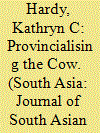

|
|
|
|
|
| Summary/Abstract |
This paper examines the ritual and everyday practices of a family of buffalo-keeping Yadavs in Varanasi, Uttar Pradesh. Water buffalo and indigenous Indian cattle are described as biologically and socially distinct beings: buffalo are economic animals, favoured for milk production, but ritually devalued and legally killable; cattle are sacred, protected from slaughter. Cows have historically been the animals central to public imaginations of Hindu belonging in scholarship and popular politics. But buffalo, not cows, are the animals central to Yadav self-making. This paper shows how heterodox bovine beliefs and everyday practices knit buffalo into a capacious Hindu interspecies world that subverts contemporary cow politics.
|
|
|
|
|
|
|
|
|
|
|
|
|
|
|
|
| 12 |
ID:
169993
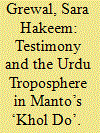

|
|
|
|
|
| Summary/Abstract |
While scholars of Partition frequently reference witnessing as a necessary frame for understanding Partition literature, and particularly the work of Saadat Hasan Manto, I analyse Manto’s short story ‘Khol Do’ (‘Open It’) to argue that the text’s use of Urdu-inflected tropology both deploys and exceeds the discourse of testimony. Through its turn toward magical realism in its devastating ending, ‘Khol Do’ demonstrates both the futility of attempting to definitively fix meaning in the context of unrelenting ambiguity, as well as the vital necessity of Urdu literature in constructing new communities of reading and interpretation in the wake of the ruptures of Partition.
|
|
|
|
|
|
|
|
|
|
|
|
|
|
|
|
|
|
|
|
|